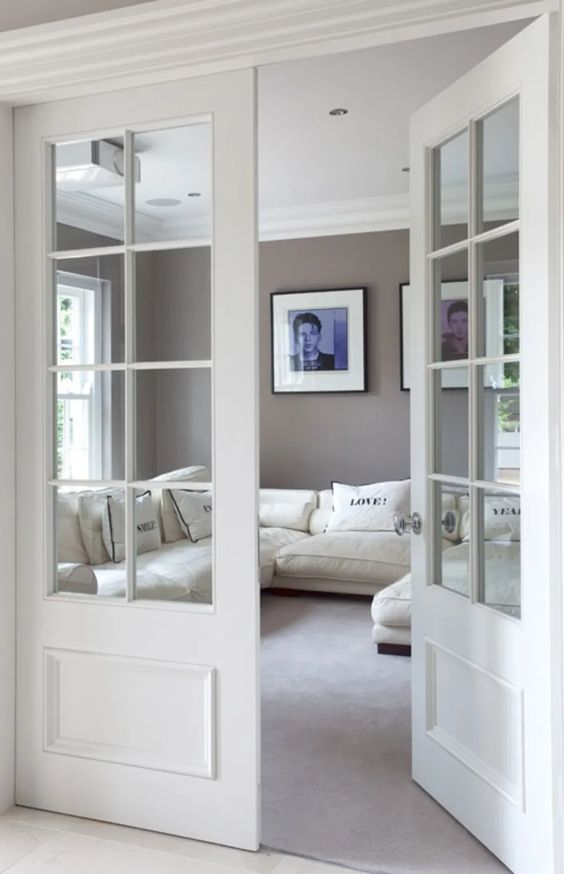Interior French doors will never not be popular. They’re the perfect way to allow natural light into a space whilst connecting two rooms, but leaving the option to close them off for more private space. We like to be able to open spaces up and close them off again when we want a little more privacy. Using interior French doors is the best way of doing that. They’re both incredibly stylish, and practical. We bet you didn’t know just how many things you have to think about before you’ll install them in your home.
What type do you want? Would you prefer them finished or unfinished? What type of glass will you use and how do you want that glass to be laid out? If those questions have all left you scratching your head, don’t worry, because in today’s post we’ll clear it all up by answering all those questions (and much more besides). So welcome to our ultimate guide to choosing interior French doors!
What Are Interior French Doors?
To kick things off, let’s just cover what interior French doors are and what they do for a space. When we hear French doors, we usually think of exterior ones that open out into an outdoor space. They allows a lot of the outdoor light to flood in because of the window panes set into the doors. Well, interior French doors are similar in design and concept, and they do much of the same thing, except they connect two internal rooms together.
They’re characterized by two doors that sit side by side, and they have window panes set into them to allow more light to pass through them. There are lots of different types, and they can come in all sorts of materials. Here’s a quick rundown of what interior French doors are often made of:
- Wood (hardwood or engineered)
- Vinyl
- Metal
- Fiberglass
There’s many more you can explore with different manufacturers, but you get the point. If you’re thinking of adding interior French doors to connect two spaces in your home, then you’ll definitely be able to find one to match your style. By far though, it is wood interior French doors with different styles of glass panes that are most popular. But even if you’ve made your mind up about the materials used, you still need to think about the style of French door you want.
What Types Of Interior French Doors Are There?
There are lots of different styles/types of interior French doors. They boil down to 4 main ones, and we’ll talk more about them below. So you can begin to think about how they might work in your home. How they’ll look, and, practically, which one is the better fit.
Interior French Doors
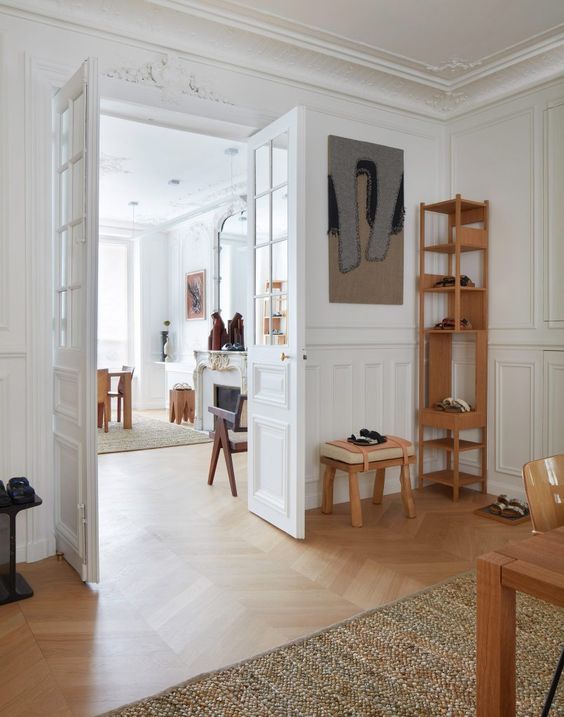
Let’s start with some classic interior French doors. These, really simply, are two doors next to one another that open inwardly or outwardly. Depending on the room you’re in and the way you have them set up. The light they allow through comes solely from the panels in the door. These can be in lots of different styles depending on your taste and how many panes of glass you want based on privacy.
Image: Vinson & Co
Interior French Doors With Sidelights
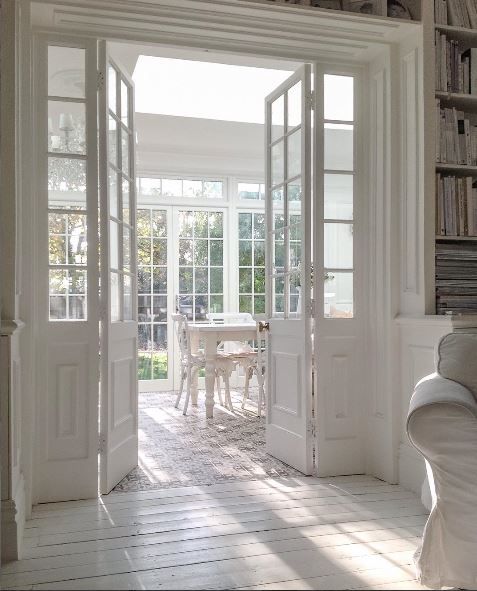
These interior French doors work exactly the same way. Rather than having a solid wall next to the doors, a bigger entranceway is created between the two rooms. The interior French doors can be fitted as before, but this time they’ll also have additional window pane panels on either side of the door. These sidelights, as they’re called, are fitted permanently into place as though they’re a solid wall. They’re very stylish and allow even more light to pass from one room to the other. They’re also commonly used when the entryway between two rooms is too large for interior French doors alone, and custom sidelights are added to fill the space whilst still being in keeping with the style of the doors.
Frenchfold/Bifold French Doors Interior
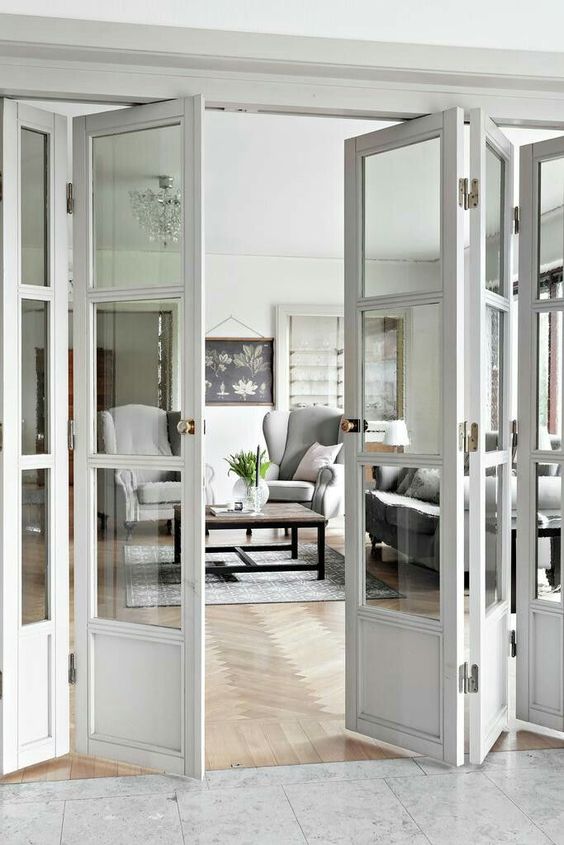
Frenchfold or bifold French doors basically combine classic French doors with bifold ones. They create a really stylish door that can open up more than any of the others covered so far. This style of door gives you options too. You can open up the French doors in the middle like classic interior French doors, and leave the side panels in place to act as sidelights. Or, you can then also fold back the side panels too, creating a large opening. The whole door basically folds in on itself, creating an open plan feel between two rooms. This style is especially useful for people who like to host large parties. It gives you the freedom of opening up two separate spaces into one large one for events, and then close them off to separate spaces again once the party is over.
Sliding French Doors Interior
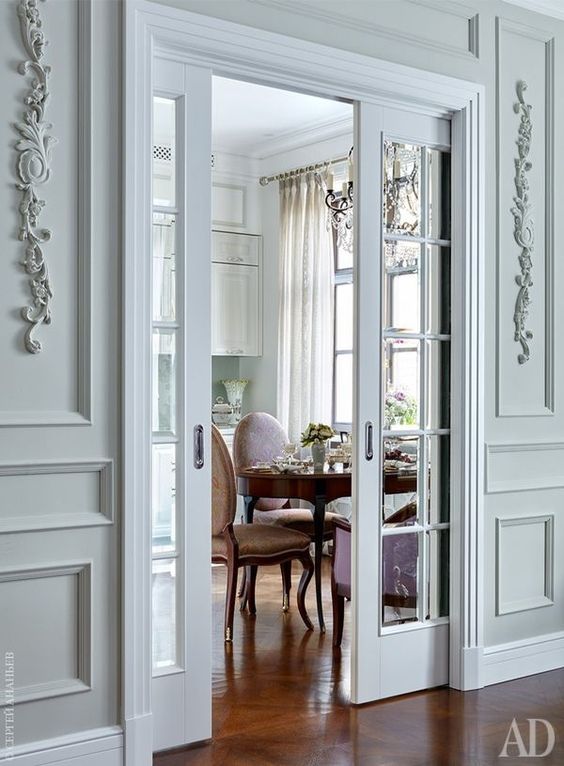
Sliding French doors are a great, unique way of opening up spaces. Where traditional French doors open inwardly or outwardly on hinges, these simply sit on tracks and are weighted, so they slide back and forth to open and close. Once closed, there are two sidelights sitting on either side of the door. And then when you open it, the doors slide to sit in front of the sidelights, opening up the space. These are great if space is at a premium in your home. You won’t lose the corners of your room because of the opening/closing arc of your traditional French doors.
Image: AD
What Sizes Are Available?
If you’re wondering about whether or not you have the space for interior French doors in your home, then you’ll at least be happy to hear that even across all the different styles, they have a pretty standard size. The frame for the French doors themselves (ignore any sidelights for the time being) stand at just over two meters tall. This is fine for most homes, and will be around 1.25m wide. So you should probably measure the space between them to make sure they fit.
If the opening between the two rooms is actually much bigger, then don’t fret. Installing sidelights is the way to go, as these are much easier and cheaper to custom make than the doors themselves. Meaning anyone with too big an opening can fix the issue easily and cheaply with sidelights. But what if the space is too small?
Well, you can get tradespeople who will custom make smaller French doors for you, so if you’re passionate about it, then consider contacting some businesses in your area to discuss your options. But be prepared for a much heftier bill at the end of it. And talking of bills…
How Much Can You Expect Them To Cost?
Let’s start with the good news. Interior glass French doors are much cheaper to install than exterior ones. That’s because they don’t need to be treated for weather conditions, etc. The bad news is, installing them is still a pretty big project. If you’re lucky enough to already have the space between two rooms quite open, then filling that space with your new doors will be much easier for the people who come in to install them for you. If, you currently have no opening between the two rooms, or just a simple single doorway connecting them, then the space will need to be opened up by professionals using a little demolition work. This, of course, will cost you.
The price increases again based on materials used. Hardwood, oak French doors are much more expensive than engineered wood that look like oak, but at a much cheaper cost. And as we mentioned in the last section, custom building interior French doors will also make the project more expensive.
So, how much can you expect them to cost? Realistically, anywhere between $300 and $3000. It can be as cheap or as expensive as you make it. Even if opting for more expensive materials, you can always look around for the cheapest options. So be sure to compare quotes from different businesses before jumping in.
Would You Like Them Finished?
Hopefully, by this stage in the guide, you’re starting to get an idea about the interior French doors you want. You’ve thought about materials, you’ve thought about style, and you’ve also considered the sizes of the doors and the cost of the project. That’s great, now we need to talk about finishes. The most popular material for interior French doors is wood. Wood French doors will come either finished, unfinished, or primed, and deciding what you want depends on a few things. So let’s look at them all closer.
Finished
Finished French doors come ready to install, and once they’re in, they’re in. You won’t need to prime them, paint them, or adjust them in any way. Buying them finished is a great idea if you just want a traditional French door look. For example, if you had quite a rustic, cottage core style going on in your dining area and kitchen, then using traditional oak French doors that just leaves the natural wood exposed to connect the spaces is perfect.
Unfinished
Unfinished doors need a little more work. If they’re fully unfinished, then they won’t have been primed, protected, or painted. It’s all left to you (or someone else, but this will come at an additional cost). This option might sound silly, but actually it’s the best way to get them from an interior design perspective, because you can match the style to what you already have in your space. If everything is quite cool-toned and monochrome in your house, then bold wooden doors would look out of place, but a slate gray or off-white wouldn’t.
Primed
Primed doors are essentially unfinished, but they’ve been treated and primed. Your last job is simply painting them to match your interior design style. This is great for people who want to customize their French doors to suit their space, but by doing the least amount of work possible. (And that sounds good to us).
Deciding between the three options will have a small impact on cost. The decision should be based on how much customizing you want to be able to do to them to make them fit into your space.
Tradition vs Custom
Tradition French doors, for those of you looking to create a classic French look in your home which is always popular and very stylish. Especially classic French design right now because the pale color scheme and soft curved lines are very ‘in’. Then there’s a ‘proper’ way of styling your windows in the door. The top part of the door has to have a panel of rectangular glass panels in a two by eight grid. And that’s on both of your French doors too.
But you can customize the windows however you please. You can create an interior glass French door that’s mostly glass with a small frame. You can have one side with more windows than the other to shield parts of the room from view of one another. Heck, you can abandon the rectangular glass panels altogether and opt for something quirkier to fit your style.
The choice really is yours, but think about how they’ll work in the space.
Best Ways To Use Them
Talking of space, we thought it’d be a good idea to talk about some of the best ways to use your interior French doors to finish today’s post. Sure, you might already know which two rooms you want to connect, but seeing some different ideas might inspire you to think of a better place for your French doors. So here’s a quick list of the best/most popular connecting room combinations to use French doors in:
- Bedroom & Walk-in closet

- Dining room & Kitchen

- Kitchen & Pantry

- Dining room & Living area
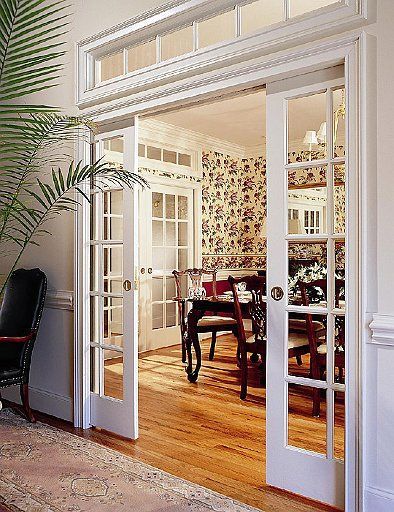
- Living area & Kitchen
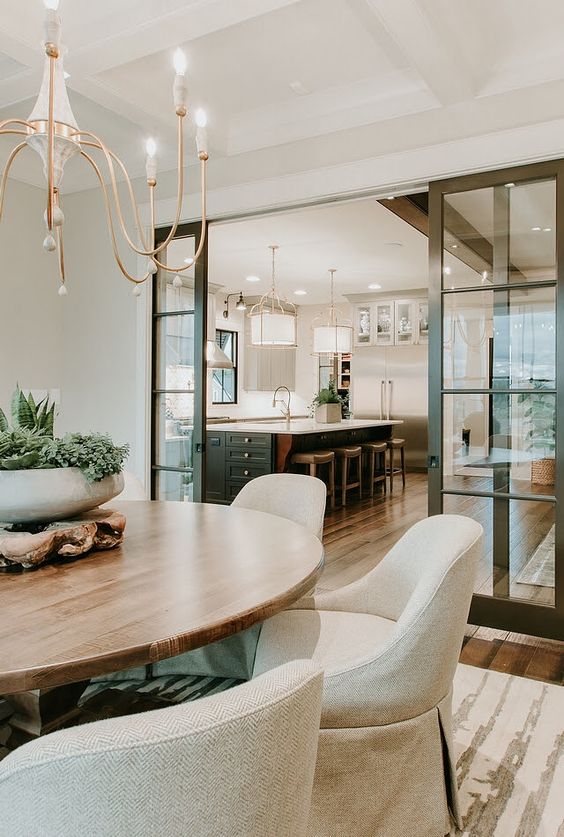
- Living area & Home office

Image: Kate Marker Interiors
- Living area & Bedroom
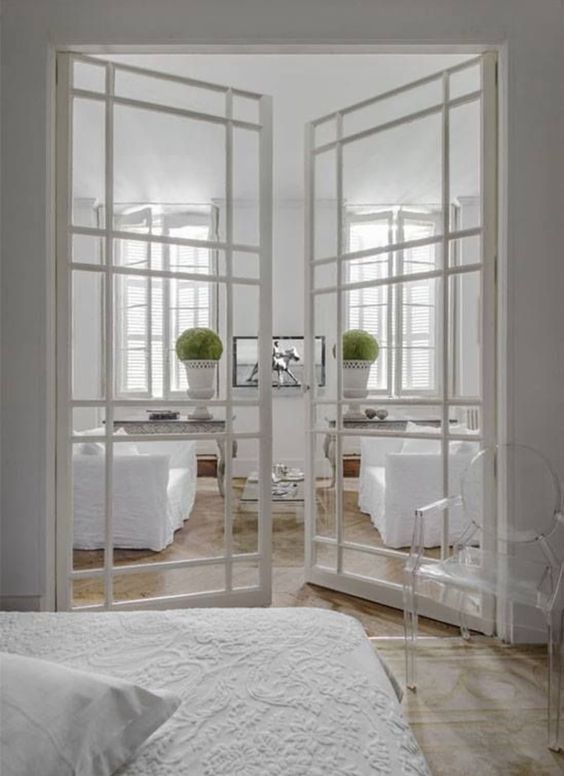
Image: L’Hotel Particulier
- Bedroom & Bathroom
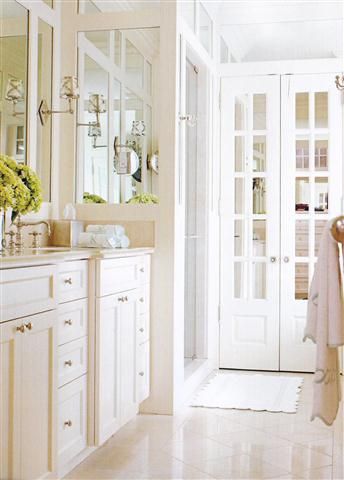
- Living area & Reading nook
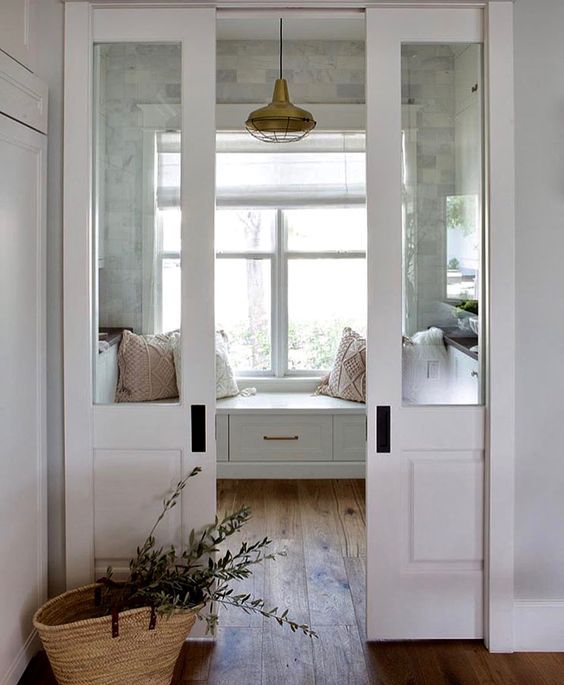
You get the idea, right? You can really make the most of your interior French doors from an interior design perspective by linking up different spaces you hadn’t thought about. By doing so, you give yourself room to play with the layout of your house. Often in interior design, it isn’t the decorating of a room people have an issue with, it’s the stagnant feel of a space. Interior French doors can change that completely, allowing more light and giving more options for opening and closing spaces to make rooms feel refreshed.
However you decide to use your interior French doors, we hope this guide has been useful and allowed you to think of everything so you can buy the ones that are right for you!
Tags: indoor doors
